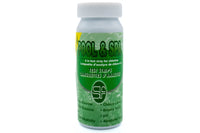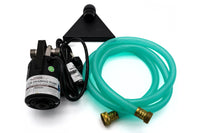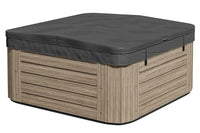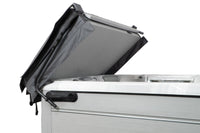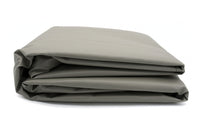One factor that can affect your hot tub over time is the hardness of the water in your area. Too hard and your tub water can become cloudy. Too soft and your tub can become pitted and marked. Calcium chloride for hot tub maintenance can make a huge difference to your ongoing tubbing experience.
Whether you’re a proud hot tub owner or thinking about becoming one, understanding how to maintain the chemical balance of your hot tub water is crucial. This guide is all about the benefits of using calcium chloride, how to use it properly, and answering some common questions or concerns.
What is calcium chloride?
Calcium chloride is a salt compound used in various applications, including as a de-icer for roads in winter. But in the world of hot tubs, it’s used for managing water hardness because water hardness can affect your tub and tubbing experience. Water that’s too hard can turn your hot tub water cloudy, while too soft water can damage the tub itself, leaving small pock marks in the finish of your tub.
Calcium chloride can help. Here’s how:
Increases water hardness
Adding calcium chloride to your hot tub effectively increases the calcium level, crucial in preventing the water from becoming too soft. This adjustment helps maintain the structural integrity of the hot tub and ensures the water is just right for use.
Prevents corrosion and etching
Calcium chloride plays a vital role in balancing water hardness, which in turn protects your hot tub from potential damage. This balance prevents the corrosive and etching effects that imbalanced water can have on hot tub surfaces and components.
Maintains water balance
Maintaining the overall chemical balance of your hot tub water is essential for optimal performance, and calcium chloride helps this balance, ensuring the water environment is stable and conducive to a long-lasting hot tub experience.
Enhances bather comfort
Properly balanced water, achieved with the help of calcium chloride, not only feels better on your skin but is also safer for you to enjoy. It minimizes the risk of skin irritation and enhances the overall comfort of your bathing experience, making your hot tub sessions more enjoyable.
How to use calcium chloride in your hot tub
Using calcium chloride in your hot tub might sound like a chemistry experiment, but it’s pretty straightforward. Here’s what you need to do.
Consult the hot tub manufacturer’s manual
Before attempting adjustments or maintenance, consult the hot tub manufacturer’s manual. This ensures you’re adhering to specific guidelines designed for your hot tub model, preventing any potential damage, or voiding warranties.
Test the water
The next step in maintaining your hot tub’s chemical balance involves testing the water about once a month. Determine the current calcium hardness level to understand how much adjustment is necessary.
An optimal level is between 150 parts per million (ppm) and 250 ppm. Too little calcium, you’ll need to add calcium chloride. Too high? Add more water to dilute.
Calculate how much you’ll need
After determining your hot tub’s current calcium hardness level, calculate the amount of calcium chloride needed to achieve the optimal balance.
Pre-dissolve the calcium chloride
To ensure even distribution and prevent any potential damage to your hot tub’s surfaces or components, pre-dissolve the calcium chloride in a bucket of water from the tub itself. This step aids in the smoother integration of the chemical into your hot tub water.
Test again
Once you’ve added the pre-dissolved calcium chloride to your hot tub and allowed it to circulate, conduct another water test. This follow-up test will confirm you’ve successfully reached the desired hardness level, ensuring the effectiveness of your treatment.
What to do if you add too much
Accidents happen, and you might find yourself in a situation where you’ve added too much calcium chloride. If guests are on their way, you’ll want to fix the problem quickly.
Partially drain your hot tub and add fresh water to dilute the calcium concentration. Click here to learn how to drain a hot tub fast. After you add fresh water, test your water again to ensure it’s back within the ideal range.
Common questions about calcium chloride in hot tubs
Calcium chloride has many applications but it’s a chemical and using it in hot tub water might inspire a lot of questions. We compiled a few to help you understand water hardness and calcium chloride.
What’s the correct level of calcium hardness in hot tubs?
For optimal hot tub performance and water quality, the ideal range for calcium hardness is between 150-250 parts per million (ppm). Staying within this range helps prevent damage to your hot tub and ensures a better soaking experience.
How do I know if I need to add calcium chloride to my hot tub water?
To determine the need for calcium chloride, conduct a water test to measure the current level of calcium hardness. If the results show a level below 150 ppm, add calcium chloride to adjust the water hardness to the ideal range.
Can adding too much calcium chloride to your hot tub water be harmful?
Yes, adding an excessive amount of calcium chloride can be detrimental to your hot tub. Overly high calcium levels can cause scale to form on the surfaces and in the plumbing of your hot tub, leading to potential damage and reduced efficiency.
A hot tub cover to help maintain your water’s hardness levels
Besides chemical maintenance, using hot tub spa covers for maintaining hot tub water quality will also help keep the hot tub water’s softness levels in check. A cover will prevent debris and rainwater from entering the tub and reduce evaporation, which can concentrate minerals in the water. Visit The Cover Guy today to find the perfect spa cover for your hot tub.
Disclaimer: The advice and information presented in this blog are for entertainment purposes only. They should not be taken as professional or expert guidance. Always consult a qualified professional before making any decisions based on this content.

